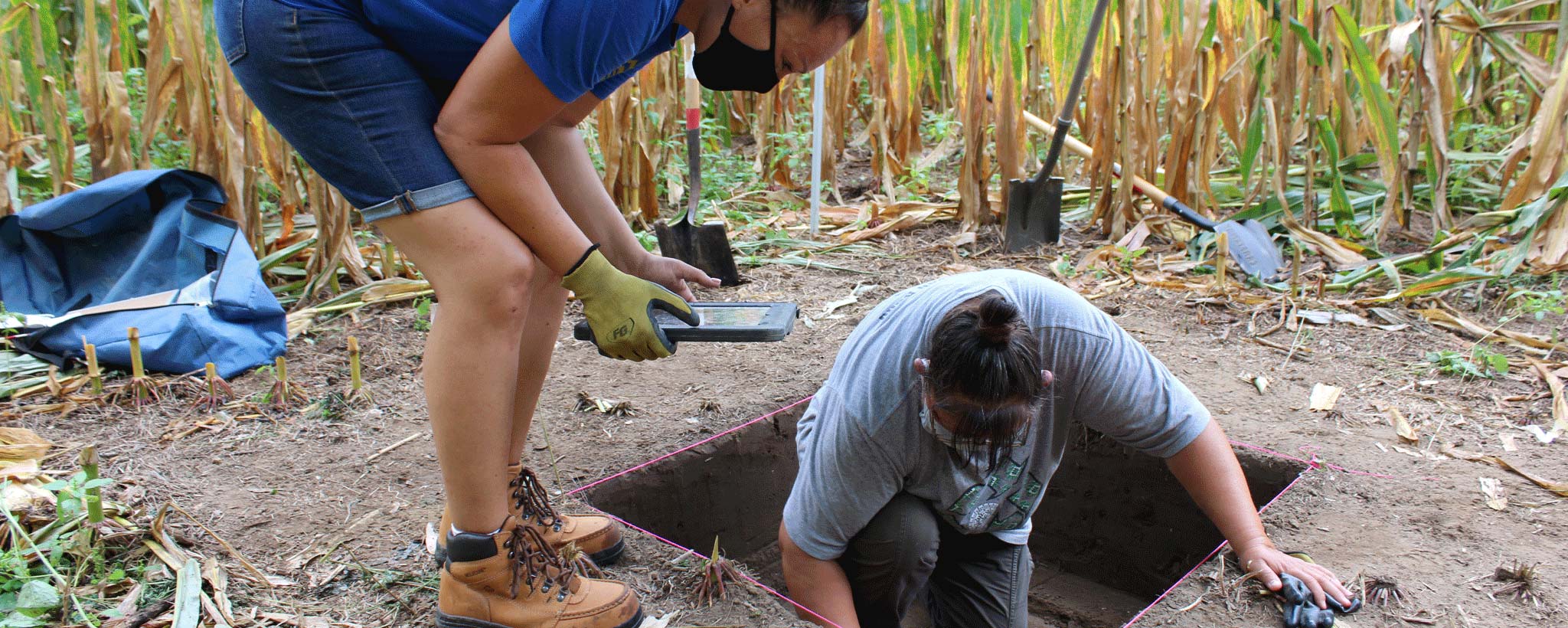Articles

Stewardship of Sacred Sites
TVA is studying the unique history of a more than 500-year-old Native American site in northeast Alabama.
NOVEMBER 12, 2020 — TVA’s archaeologists and federally recognized Indian tribes worked to develop a plan for conducting limited archaeological excavation of a site located in Jackson County, Alabama.
Members of the United Keetoowah Band of Cherokee Indians (UKB), traveling from Tahlequah, Oklahoma, were able to participate in this excavation as part of an archaeological field school. Native Americans once lived throughout the Tennessee Valley but many were forced West on federal reservations by the United States government under the 1830s Indian Removal Act.
The purpose of TVA’s summer investigation was to identify the location of archaeological features below the surface in order to know more about the extent of occupation of the site. In 2012, TVA used non-invasive, ground-penetrating radar (GPR) to determine if the site, originally identified by archaeologists in the 1930s, was still present.
GPR pinpointed locations on the ground where archaeological features may be present and meticulous hand-dug excavation confirmed. The weeklong field survey concluded in August.
According to TVA Archaeologist Erin Dunsmore, TVA manages more than 12,500 archaeological sites across the Valley. As a federal agency, TVA is required to document these sites and assess them for their potential significance. This allows the agency to prioritize the protection of these resources.
The use of advanced technology allows TVA to accurately map and understand these important places on public land. When excavation is required, only minimal amounts of disturbance is necessary to confirm what archaeological features are found below the surface.
First, Field Surveys
“GPR allows us to get a good estimate of what a site might have looked like because it allows us to see well below the surface for fortifications, walls and houses,” Dunsmore said. “Because of the technology, we don’t need to put a shovel in the ground to get an idea of what was there.”
When performing these types of excavations, teamwork between TVA and federally recognized Indian tribes is paramount. This partnership is a mutually beneficial relationship. TVA is able to acquire a better knowledge about Native American culture and history, while tribal representatives without an archaeological background are able learn more about the field of archaeology.
Whitney Warrior, who is the director of the UKB’s Office of Environmental Services and Historic Preservation, participated in the August field school.
“TVA plays a big role in the preservation of our aboriginal lands and the protection of many significant archaeology sites. I appreciate what they are doing to protect our heritage,” Warrior said. “TVA works to find ways to have more tribal involvement and their archaeologists have a sense of integrity and respect for Native American tribes when it comes to the preservation of archaeological resources. Without them, we wouldn’t know some of the things we now know.”
A Mississippian Village Revealed
The site under investigation is a Native American village that dates to the Mississippian Period, A.D. 1000-1500. TVA last excavated the site in the 1930s before TVA built Guntersville Dam. During the dam’s construction, excavations focused on the
mound identified in the center of the village.
TVA no longer excavates mounds as they often contain graves. The Native American Graves Protection and Repatriation Act protects Native American burials.
The summer’s excavations focused on other features within the village that helped identify how Native Americans lived during the Mississippian period. The team located an area with mussel shells and other organic material that was most likely the
remains of a midden — a domestic waste dump which often consists of food, animal bone, botanical material, mollusk shells and other artifacts associated with past human occupation.
In addition, the team uncovered evidence of the fortification that surrounded the village. Artifacts and information collected from the survey are being analyzed and the findings will be summarized in a report that will take about six months to complete.
Better Stewards of the Future
“A very important aspect of this survey work is that it helps us gain knowledge about how to better manage our cultural resources,” Dunsmore said. “While archaeology is about learning about the past, it also provides us information that will help us to be better stewards now and into the future.”
TVA is a federal agency responsible for managing more than 293,000 acres of public lands and 11,000 miles of shoreline through the Tennessee Valley. The agency serves as a guardian that preserves and protects Native American cultural sites located within a seven-state service region.
“TVA has a legal and ethical obligation to work with federally recognized Indian tribes, and to protect significant Native American resources,” said Marianne Shuler, TVA archaeologist and Tribal Liaison. “Many of these sites are the final resting place for ancestors of the tribes who once lived in the Tennessee Valley.”
November is Native American Heritage Month, and TVA is proud of its important partnerships with Native American tribes. Learn more about some of the federally recognized tribes that TVA works with throughout the Tennessee Valley.